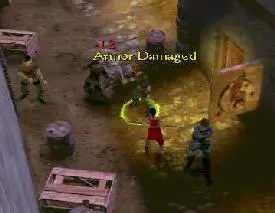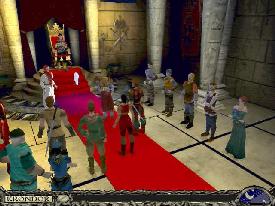Stop that Bad Man…Kill him! Kill him dead!
One of the greatest, longest, best-selling, and most enduring role-playing games of all time is Betrayal at Krondor. It featured a vast world, tactical combat, and a richness that actually managed to pull in even non-RPG gamers. Based on Raymond Feist’s line of Midkemia novels, Betrayal at Krondor had a depth of story and character that rivaled even Origin’s seminal Ultima series. Now, after suffering through the pseudo-sequel Betrayal at Antara, we the gamers are now presented with a true sequel to one of our most revered classics: Return to Krondor.
Explaining why Return to Krondor (and not Betrayal at Antara) is the actual sequel to Betrayal at Krondor would take some time. It would also most likely bore you to death with words like “license” and “developers” and “legal” and so on and so forth. Take my word for it, Return is the actual sequel, while Antara was just a very, very similar game using an updated version of the original Krondor engine that, because of Feist’s lack of involvement, had a disappointing story line.
Return to Krondor is a somewhat different game than its predecessor. Betrayal took place in a vast world in which the player navigated his or her (damned women’s lib makes me change my writing style) party using an overhead map, punctuated by quasi-3D tactical combat or trap evasion at key points. Return, however, takes place entirely in third-person and in a much smaller, more focused area. The game works much like an adventure game in that you move 3D characters over pre-rendered backgrounds. The combat now is seamlessly incorporated into the gameplay.
The plot involves an almost immortal pirate (bad man) who is after a sacred
artifact called the Tear of the Gods. Following in the tradition of bad men throughout
history and fantasy, this bad man wants the Tear of the Gods in order to create
some very serious bad mojo. It is now up to you and a party of 5 to stop him.
Your party includes Squire James (Betrayal fans remember him as the thief
Jimmy the Hand), Jazhara the court mage (voiced by Neve Campbell? Or Jennifer
Love Hewitt?), a Priest-Warrior named Solon, Kendaric of the Wreckers Guild (everyone’s
favorite afternoon tea-club), and William, the guard of Krondor.
There are several new aspects of Return to Krondor‘s gameplay that differ largely from Betrayal. An extensive alchemy system requires your mages to transport much equipment, which allows you to make you own spells. Also, the game gives you an option of how you want to deal with traps and booby traps. You can let it be a chance roll of the dice based on your ‘skill at traps,’ much like Betrayal. The other choice is ‘reflex,’ which incorporates an innovative system of actually controlling your tools with the mouse to pick locks and disarm defense systems.
The graphics in Return to Krondor are exceedingly well done. The pre-rendered backgrounds are some of the most detailed settings yet seen in this style of game. They actually manage to go head to head with the excellent Grim Fandango. Also, the 3D characters are very well modeled and animated. There are some very tasty special effects for fire and spells that add nicely to the eye-candy. The game also features some very well rendered cut scenes now and then.

Return to Krondor features D3D support and a software mode that yields results that are extremely close to the D3D option. The software mode, called True3D, will run at a very acceptable framerate on anything over a Pentium 200, so those of you who actually don’t have a 3D accelerater yet aren’t left out in the cold.
The sound is also very adept. Return to Krondor uses high-quality CD audio to set the background tones to the game. Return also uses 3D positional Environment Audio to add to the atmosphere of the game and the story. In a fairly refreshing display of production values, Return features some of the best voice acting yet seen in a RPG. Overall, the sound does an excellent job of setting the tone and plays a significant role, like in a movie, of carrying the story.
The story itself was actually written by Feist. As such, the story is highly
involving and well-paced. The characters are good, the settings are fantastic,
and the climax is invigorating and leaves you wanting another sequel. My only
complaint is that it only takes about 40 hours top reach the climax. This makes
Return one of the shortest RPGs since Diablo.
Also, since the plot and gameplay is highly linear, there is little replay value.
Yes, it is a thoroughly enjoyable 40 or so hours, but that simply isn’t going
to be enough to satisfy RPG fans used to vast games like
Daggerfall, Ultima, and Betrayal at Krondor.
Other problems with the game include a slightly problematic system of shifting between camera angles and a tendency for the sound to sometimes not function properly. Sierra has released a patch, however, to deal with these and other issues.
Slight bugs and lack of longevity aside, this is one of the most invigorating and addictive RPGs to come out since Diablo rocked the PC gaming world way back in 1996. In the less than stellar popular field of computer RPGs, Return to Krondor has some of the best plot, gameplay, and production values seen in a while. Now, Return to Krondor is titled Book One. If Book Two lives up to this one and the aging prequel, we very well may have a phenomenon on our hands.
-
Good Plot
-
Terrific Graphics
-
Excellent Sound
-
Too Short
-
Just a Few Bugs











